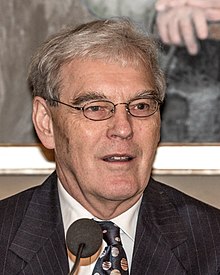Richard Henderson | |
|---|---|
 Henderson during Nobel Prize press conference in Stockholm in 2017 | |
| Born | 19 July 1945 Edinburgh, Scotland |
| Alma mater | |
| Known for | Cryo-electron microscopy[2] |
| Awards |
|
| Scientific career | |
| Fields | |
| Institutions | |
| Thesis | X-Ray Analysis of α-chymotrysin: Substrate and Inhibitor Binding (1970) |
| Doctoral advisor | David Mervyn Blow |
Richard Henderson CH FRS FMedSci HonFRSC (born 19 July 1945)[3] is a British molecular biologist and biophysicist and pioneer in the field of electron microscopy of biological molecules. Henderson shared the Nobel Prize in Chemistry in 2017 with Jacques Dubochet and Joachim Frank.[4] "Thanks to his work, we can look at individual atoms of living nature, thanks to cryo-electron microscopes we can see details without destroying samples, and for this he won the Nobel Prize in Chemistry."[5]
Henderson was educated at Newcastleton primary school, Hawick High School and Boroughmuir High School.[3] He went on to study Physics at the University of Edinburgh graduating with a BSc degree in Physics, 1st Class honours in 1966.[3] He then commenced postgraduate study at Corpus Christi College, Cambridge,[6] and obtained his PhD degree from the University of Cambridge in 1969.[3][7]
Henderson worked on the structure and mechanism of chymotrypsin for his doctorate under the supervision of David Mervyn Blow at the MRC Laboratory of Molecular Biology.[8] His interest in membrane proteins led to him working on voltage-gated sodium channels as a post-doctoral researcher at Yale University. Returning to the MRC Laboratory of Molecular Biology in 1975, Henderson worked with Nigel Unwin to study the structure of the membrane protein bacteriorhodopsin by electron microscopy. A seminal paper in Nature by Henderson and Unwin (1975)[9] established a low resolution structural model for bacteriorhodopsin showing the protein to consist of seven transmembrane helices. This paper was important for a number of reasons, not the least of which was that it showed that membrane proteins had well defined structures and that transmembrane alpha-helices could occur. After 1975 Henderson continued to work on the structure of bacteriorhodopsin without Unwin. In 1990 Henderson published an atomic model of bacteriorhodopsin by electron crystallography in the Journal of Molecular Biology.[10] This model was the second ever atomic model of a membrane protein. The techniques Henderson developed for electron crystallography are still in use.
Together with Chris Tate, Henderson helped develop conformational thermostabilisation: a method that allows any protein to be made more stable while still holding a chosen conformation of interest.[11][failed verification] This method has been critical in crystallising and solving the structures of several G protein–coupled receptors (GPCRs).[12] With help from the charity LifeArc, Henderson and Tate founded the MRC start-up company, Heptares Therapeutics Ltd (HTL) in 2007.[13] HTL continues to develop new drugs targeting medically important GPCRs linked to a wide range of human diseases.[8]
In the last few years, Henderson has returned to hands-on research focusing on single particle electron microscopy. Having been an early proponent of the idea that single particle electron microscopy is capable of determining atomic resolution models for proteins, explained in a 1995 paper in Quarterly Reviews of Biophysics. Henderson aims to be able to routinely obtain atomic structures without crystals. He has made seminal contributions to many of the approaches used in single particle electron microscopy, including pioneering the development of direct electron detectors that recently allowed single particle cryo-electron microscopy to achieve its goals.[4]
Although Henderson has typically worked independently, he has trained a number of scientists who have gone on to independent research careers. These scientists include:
Henderson has worked at the Medical Research Council Laboratory of Molecular Biology (MRC LMB) in Cambridge since 1973, and was its director between 1996 and 2006.[15] He was also a visiting professor at the Miller Institute of the University of California, Berkeley in Spring 1993.[16] He is currently[when?] a mentor for the Academy of Medical Sciences Mentoring Scheme.[8] Outside academia, he lists his interests as hill walking in Scotland, kayaking and drinking good wine.[3][8]
He was interviewed by Jim Al-Khalili for The Life Scientific, first broadcast on BBC Radio 4 in February 2018.[2]